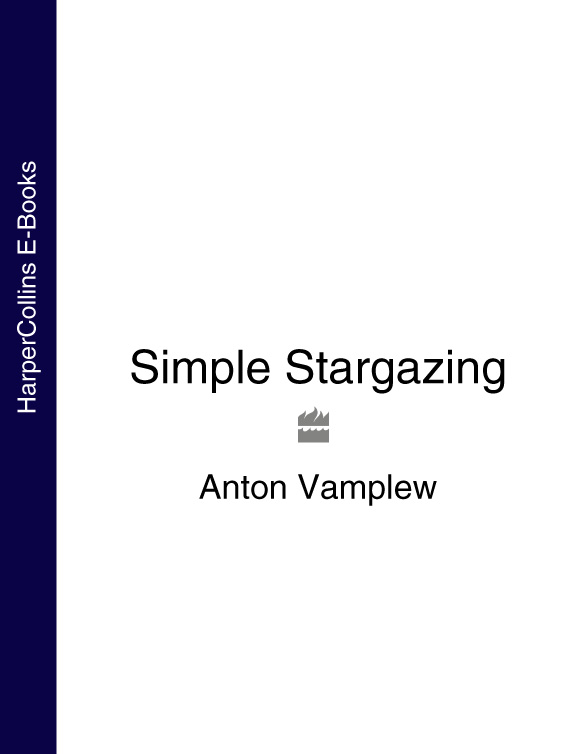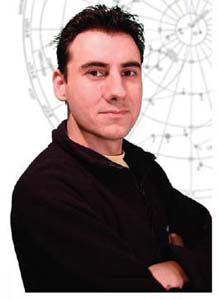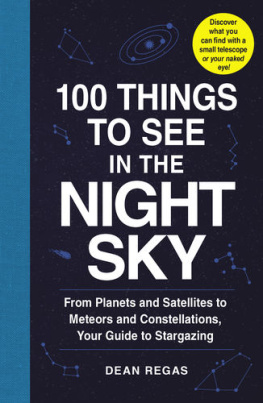
For Morten, Etienne and Dad
Special thanks to my wife Gillian, Greg Smye-Rumsby and Peter Michaud. My star planetary images were taken using an Epson 3000z PC digital camera. Thanks to Janice Gibson at Epson UK for the use of this camera.
Prepare yourself for an adventure that will take you deep into space and far back in time. This great journey begins the moment you cast your eyes up into the night sky. After a while youll be looking beyond the stars, wondering about distant life or maybe thinking just how fantastically big this whole Universe thing is.
I vividly remember when I was six, gazing out of my bedroom window with a desire to learn the names of the bright stars and the patterns I knew existed in the form of constellations. Little did I know what I had started a lifelong trip which never ceases to amaze me. We are now in the age of Hubble, Cassini, Galileo, Hipparchos and Messenger (etc., etc.) spacecraft that open up the vistas of the Universe to realms that excite while causing us to constantly rearrange our jigsaw of well, everything. And this is not going to slow down. Look out for specially trained astronauts on the Moon and Mars, and ordinary astronauts (thats you and me) taking short trips into space.
Hopefully I can share some of my wonderment through these pages. None of this is rocket science (apart from the rocket science stuff). The name of the stargazing game is easy, short observing whenever you have a few spare moments while the stars are twinkling overhead.
Oh, but I cant see the stars from where I live, is always a good one. Read carefully, as this will be written only once: living in a town, city or anywhere with light-polluted skies need not deter anyone from stargazing. Although the sky glow washes out the fainter stars, the major constellations will still be visible. So you wont be hindered from learning the main star patterns. No excuse there, then!

Dont underestimate the power of doing something. Simply by taking a few minutes each day over the course of a year youll soon be amazing your friends as you point out Leo and say, Of course, Regulus is a B7-type star about 85 light-years away. Or you might glance at the Square of Pegasus, remarking casually, Messier 15 over there was discovered by the wonderful Italian, Maraldi. Or even dreamily waft your hand in the direction of Orion, and with a certain authority launch into, The dimensions of M 42 are 66 by 60 arc minutes. It wont take long to learn the night sky, and I hope this book will inspire you to make a start.

The night sky is out there. As this old map shows, its all prepared and ready for you to explore.

Part 1
Getting Started

A fine sunset is worth a picture itself as well as the hint that its going to be a fine, clear, starry-skied evening. Just the prompt you need to get you into the stargazing frame of mind.
In the distant past, astronomy and astrology were as one. Ancient rulers needed to know their fortune and, as the sky was where their gods lived, it was also where their destiny lay. Along with all the fixed stars of the constellations were seven things that moved: the Sun, Moon and five planets Mercury, Venus, Mars, Jupiter and Saturn (this was, of course, in the days when everyone believed that the Earth was the centre of the Universe and other sky objects moved round it).
It was an absolute belief that leaders who could understand how these objects moved could stay in control and defeat their enemies. One thing was clear: to these ancient watchers of the skies these seven objects followed a path around the heavens just like a car on a race track that takes the same route round again and again. It was the constellations situated along this path that became our 12 famous signs of the zodiac.
Of course, in order to know where any object would be in the zodiac at any given time, a certain amount of calculation was required. This is when the science of astronomy was born. So, strangely, the necessity for fortune-telling encouraged the formation of science. By the way, zodiac means line of animals (11 of the original 12 constellations are still animals) and is also linked to the word zoo.
So, why do the planets, Sun and Moon appear to move through the skies? Well, they each appear to move for different reasons. Of course the main movement you see is due to the Earth spinning this gives us things like sunset, the Full Moon rising over frosty trees, time for your cornflakes for breakfast as the Sun rises, etc. The Moon, if it is up, additionally appears to move extremely slowly hour by hour in front of the stars because it is orbiting the Earth. The Sun changes its position against the stars day by day due to the fact that we are orbiting it. The planets move because they too are orbiting the Sun plus each planet is moving at a different speed. No wonder it was all difficult to calculate, and indeed its hardly surprising that some early astronomers ended up having their heads chopped off, when their erroneous adding up was followed by a total overreaction from their bad-tempered rulers.
A word worth defining before we launch ourselves into space is constellation. Its based on a word from Latin meaning group of stars. In total youll find 88 of them filling the entire sky, but thankfully you dont need to know them all to enjoy the hours of darkness. Other starry terms that crop up throughout the book are written in bold and explained in the AstroGlossary in .
The story of organising things up there in the darkness of the night began thousands of years ago with civilisations such as the Sumerians, Babylonians, Egyptians, Greeks and Romans (as well as many other cultures from around the world). They decided the starry skies could do with a bit of order and a tidy up. So they joined up many of the stars, just like a dot-to-dot picture, putting their myths and legends into the sky as they did so.
Dont think that there was any rhyme or reason for making a particular pattern. For example, Cepheus, King of Ethiopia, and his wife, Queen Cassiopeia, both have constellations named after them, and yet these look like a house and a set of stairs respectively. Imagination is the key here, I feel. As far as these early civilisations were concerned, the gods and goddesses needed a place to reside in the starry vault, so it was probably a case of first come, first served, and pot luck as to which stars were assigned to which group.
We get our earliest knowledge of the constellations from Aratos, the first Greek astronomical poet, in his work Phaenomena (which was probably based on an earlier lost work by another Greek, Eudoxus). Then in AD 150 Ptolemy, a Greek working at the great library of Alexandria in Egypt, recorded them in a book known by its Arabic name, Almagest, which means the greatest. Hundreds of years ago, other astronomers who wanted to be famous added extra groups (some more successfully than others) to give us our present fixed total of 88 constellations.















